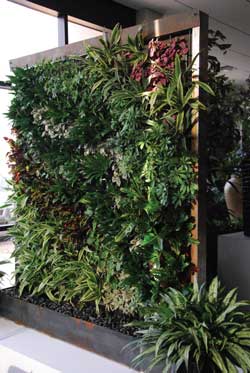
Vertical Wall Gardens
Download a PDF of this fact sheet.

Vertical wall gardens grow plants on walls, whether they are indoors or outside. This type of vertical gardening is becoming popular in areas that have poor growing soil, or little soil, like in urban areas. Like vertical gardening, vertical wall gardens bring plants to eye level. This takes most bending and kneeling out of plant care. Vertical wall gardens also have a cooling affect on the space around them.
There are a couple of differences between vertical wall gerdening and vertical gardening. Vertical wall gardens grow non-vining plants, like moss, alyssum, and orchids, on thin panels usually without soil. The wall becomes the garden's planting area. Plants grown in vertical wall gardens are trained to grow 'out'. Another difference is that vertical wall gardens tend not to use soil. Vertical gardening tends to use vining plants, like peas, tomatoes, and cucumbers, which naturally like to grow up or sprawl. These plants are either tied to vertical structures or use their own ability to grip things to grow on and climb. Vertical gardening grows plants with soil and in the ground.
Growing plants that do not mind growing out, instead of up, and use hydroponics (growing plants without soil) will do best. Plants that climb, creep, trail, or ramble can also be grown in this type of garden. Cacti, ferns, orchids, mosses, grasses, and air plants are examples. Plants that grow on another plant or structure, like a rock, also grow well in vertical wall gardens. Flowering plants, like alyssum, impatiens, moss, and roses, are examples of plants that are often used to fill in extra room on the living wall. Filling in all areas of the wall garden will make it look like a colorful carpet. Avoid growing plants that sucker onto surfaces if brick is being used.
Basic Construction
There are many different ways to build a vertical wall garden. Ideas range from simple to complex. One way to quickly make a vertical wall garden is to mount a large, trough-shaped planter box on the side of a wall. A more difficult way to build one is described below.
- Build a wood frame that can hold a four foot high, five foot wide, and eight inch thick block of soil-less mix. (Soil-less mix can be a nutrient mix that feeds plants. It can also be medium culture that takes the place of soil. Medium culture can be made out of brick shards, clay pellets, gravel, rock wool, roof venting fiber, plastic fiber materials, insulation panels, and carpet padding. For more information, see 'Accessible Gardening: Hydroponic Gardening' fact sheet.) Fasten the frame to a sturdy wall or fence at a height at which you are comfortable while gardening.
- Add a wood plank with drain holes to the bottom of the frame.
- Line the side of the frame that will face you when you are gardening with black, plastic sheeting.
- Cover the sheeting with a lightweight paneling frame, like a trellis or chicken wire. Back the paneling frame with two inch square galvanized wire fencing.
- Attach the trellis to either the left or right side of the frame with a piano hinge along the entire side. This allows the front to be unbolted from the opposite side and swing open like a door for easy emptying.
- Leave the top of the wall open in order to fill with soil-less planting mix and for general watering.

Plant care tips
- The wall, that your vertical wall garden will be on, will be in contact with water much more then it would be under normal weather conditions. This is because plants in a vertical wall garden have their roots against the wall. Putting a waterproof barrier on the wall you have chosen for your vertical wall garden will keep water from seeping through the wall. It will also help keep mold from growing. Put the waterproof barrier on before fastening the frame to the wall.
- Vertical wall gardens can be heavy. Remember to keep weight in mind when choosing a wall on which to grow your garden.
- You can water your garden with a drip water system or, by frequently giving it a soft misting of water. If you choose to use drip irrigation tubes, place them above the paneling so water constantly drips into the medium culture.
- You can grow your vertical wall garden using soil. You can do this by using paneling that is wide enough to hold small amounts of soil.
Resources
You can grow your garden on an existing wall or you can buy a kit. For more information on making your own vertical wall garden, visit www.gardenguides.com/vertical-wall-gardens or call your local agriculture extension agent.
If you would like to talk to someone about accessible gardening, or would like a garden assessment done, call Green Thumbs, Healthy Joints at 800-841-8436.

